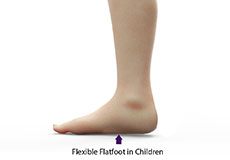Paediatric Foot Conditions

Intoeing
In toeing, also called “pigeon-toed”, is an abnormal condition characterized by inward facing of the toe or foot instead of being straight. Parents may observe intoeing in their children at an early age when they start walking. But usually intoeing corrects itself without any specific treatment as the child grows up to around 8 years of age.

Clubfoot
Congenital clubfoot is a common pediatric foot deformity. The feet twist inward and downward at the ankles in such a way that the ankle or side of the foot meets the ground while walking instead of the sole of the foot. It is twice as common in males as females. The leg and foot may be smaller and calves less developed than normal.

Metatarsus Adductus
Metatarsus adductus is a paediatric foot deformity. This is a condition where the foot of the child may bend inward from the middle to the toes. This condition is similar to clubfoot deformity.

Vertical Talus
Congenital vertical talus (CVT) is a rare condition in which the talus (heel bone) and navicular bones (ankle bone) of the child’s feet are abnormally positioned. This leads to a rigid flat foot with a rocker-bottom appearance. The hindfoot points downward to the floor while the forefoot points upwards. It occurs most frequently with other neuromuscular disorders such as spina bifida and arthrogryposis (multiple joint contractures present at birth).

Paediatric Flexible Flatfoot
Flatfoot, also known as “fallen arches” or Pes planus, is a deformity in children’s feet in which the arch that runs lengthwise along the sole of the foot has collapsed to the ground or not formed at all. Flatfoot is normal in the first few years of life as the arch of the foot usually develops between the age of 3 and 5 years.

